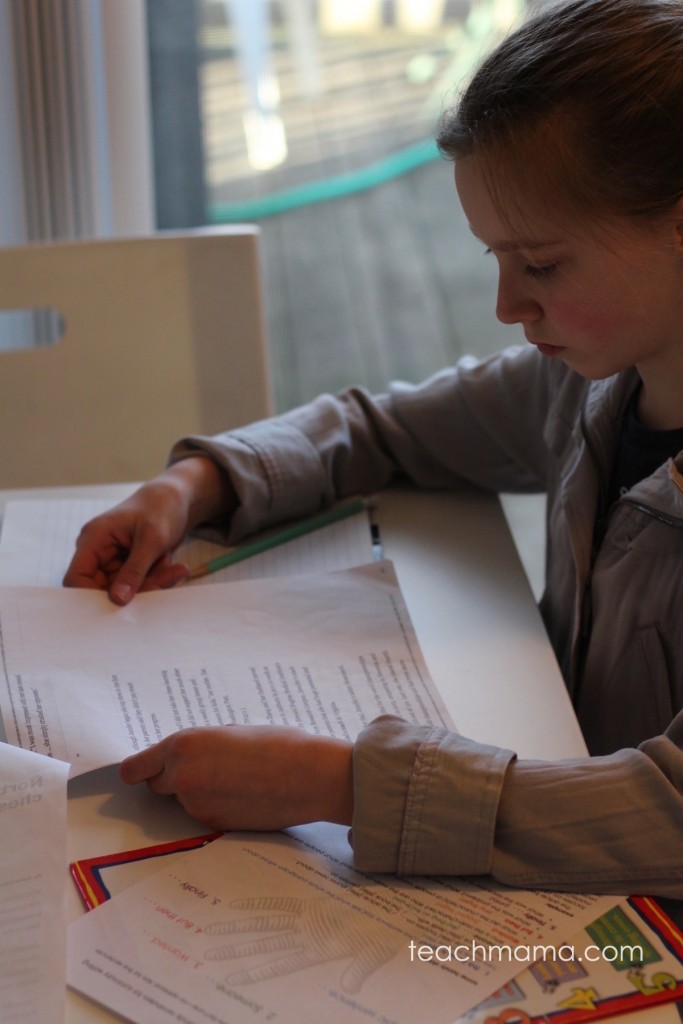Summaries are difficult.
Writing summaries, oral summaries–it doesn’t matter.
Both? Difficult.
No matter the student’s age, the act of reading something–anything–and either retelling or summarizing is really, truly tough.
Summarizing is a skill that must be explicitly taught. And it’s a skill that must be modeled.
And it’s a skill that is worth revisiting time and time again, year after year.
This year, Maddy’s been challenged with the weekly task of reading her choice of a news article and summarizing it. I love the assignment. Personally, any repeated effort to improve a student’s reading and writing skills is a win in my book.
However, her summaries were rough at first. Really rough.
So I dusted off my teaching resources, updated a few things, and handed her this: the 1-hand summary.
Here’s the skinny. . .
How to Teach Summary Writing–The 1-Hand Summary:
My goal with this was to have it work for anything Maddy chose–a news article, a magazine article, anything. And for the most part, it works.
How I began
I started with the very article that Maddy chose for her homework–a piece from The Washington Post about Jennifer Yu, a local chess champion.
Maddy knew she needed some support with her summary writing assignment; she had written summaries for about four weeks, and each time, we worked together on multiple edits.
Her summaries were not summaries.
She was including her opinion.
She was missing major details.
She was adding too much detail.
She was not including the ‘stuff’ of summaries.
It was time for the 1-Hand Summary Sheet.
We looked at the hand and talked about the components of a strong summary:
- title and author
- strong topic sentence
- facts and no opinions
- conciseness–say everything you need to say in as few words as possible
- 5 W’s and H are covered (who? what? why? where? when? and how?)
We read the article together.
And then I showed her the sample summary.
Kids must see models. They must. There’s no way kids automatically know what a good summary looks like or sounds like.
So reading the one I created helps. We talked about why it works.
We talked about some strategies to use while reading to save time later: highlighting or circling important details or putting a star or a checkmark in the margins. You can even write in the margins if it’s a newspaper article.
We talked about how this summary includes the infamous 5 W’s and H (who? what? why? where? when? and how?) but incorporates them in an easy to understand paragraph.
We talked about why the topic sentence is so important.
We talked about how you can grab words and phrases from the title of the article to make your writing easier.
why The 1-Hand Summary helps
I love the format of this 1-hand summary. Yes, it covers the typical: Someone. . . wanted. . .but then. . .finally.
But for a more advanced writer, it includes a topic sentence where students can incorporate the title and author of the piece. I think that’s important. And it will prepare kids for higher level writing down the road.
The 1-Hand Summary is here to download if you’d like. Simply throw your email in the box below, and it will end up in your inbox — like magic!
In order to succeed in school and in life, strong readers need to be able to summarize what they’ve read.
Summarizing is a foundational skill of the Common Core State Standards. It’s a building block and a necessary component of any comprehensive reading program, and summarizing is an element of every grade, every year:
CCSS.ELA-LITERACY.CCRA.R.2
Determine central ideas or themes of a text and analyze their development; summarize the key supporting details and ideas.
But even before the CCSS’s were around, we all know that summarizing is a skill necessary for success just about anywhere.
Want a few more resources for summary writing?
- summarizing and close reading
- 10 way to talk to kids about books
- questioning and connecting during read alouds
- 5 things never to say to emerging readers
- questioning to improve comprehension
A few more resources on summary writing:
- get the GIST, from readwritethink
- summary writing, from scholastic
fyi: Huge thanks to the following resources for information here: http://www.corestandards.org/ | Literacy Implementation Guidance for the ELA CCSS | The Washington Post article by Tom Jackman















 how to have a family meeting: what works for us
how to have a family meeting: what works for us